The IceCube-2 telescope beneath Antarctica hunts for ghostly neutrinos by detecting faint Cherenkov light produced when these nearly massless particles interact with the ice. Its construction involves drilling deep holes, lowering sensitive modules, and carefully calibrating them for precise detection. Despite extreme cold and environmental challenges, advanced technology and international teamwork help capture these elusive signals. If you’re curious, uncover how scientists harness this data to explore cosmic mysteries and the universe’s energetic events.
Key Takeaways
- IceCube-2 is an advanced neutrino detector embedded deep within Antarctic ice, designed to observe elusive ghostly neutrinos.
- It uses thousands of optical sensors to detect Cherenkov light from neutrino interactions in the ice.
- Deployment involves drilling deep boreholes to precisely position detector modules in a stable, transparent ice environment.
- The telescope faces challenges from environmental conditions and background noise but employs sophisticated data analysis to identify genuine neutrino events.
- IceCube-2 aims to uncover high-energy cosmic neutrinos, providing insights into cosmic phenomena and fundamental particle physics.
The Origins and Significance of Neutrinos in Space
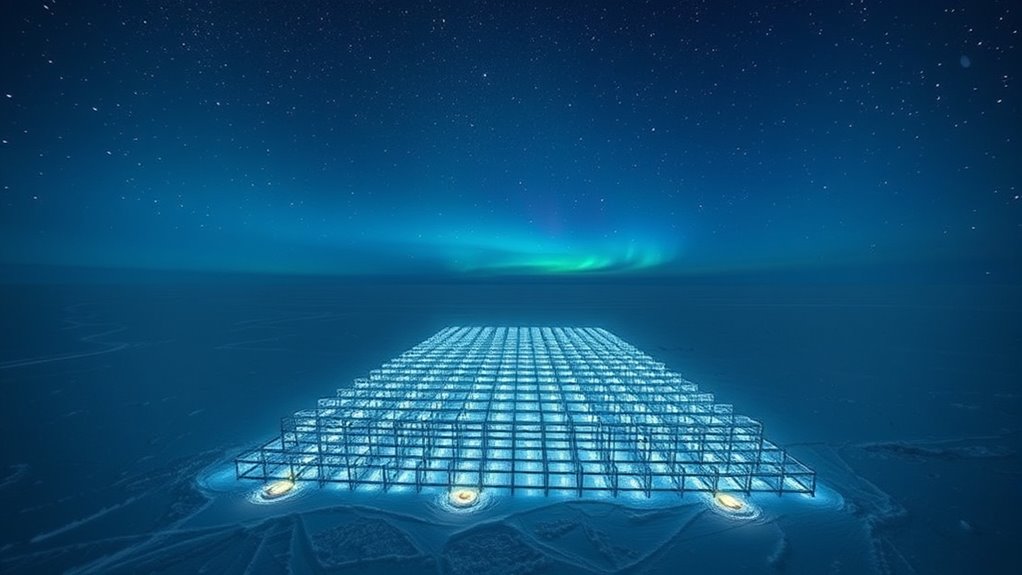
Have you ever wondered what messages the universe is sending through tiny, nearly massless particles called neutrinos? These elusive particles originate from cosmic ray interactions in Earth’s atmosphere, supernovae, and even distant galaxies. Neutrino oscillations, where neutrinos change flavors as they travel, reveal important clues about their mysterious nature and the fundamental laws of physics. Studying these oscillations helps scientists trace the origins of high-energy cosmic rays and understand processes happening in extreme environments across the universe. Because neutrinos rarely interact with matter, they carry unaltered information from their sources, making them invaluable cosmic messengers. Detecting and analyzing neutrinos deep beneath Antarctica’s ice allows you to unseal secrets about our universe’s most energetic phenomena and the fundamental particles that compose it. Color accuracy in the detection process is essential to accurately interpret the signals received from these elusive particles.
How the IceCube-2 Detector Is Constructed Beneath the Ice

To build the IceCube‑2 detector, engineers first drill deep holes into the Antarctic ice using powerful hot-water drills. They then carefully lower detector modules into these cavities with precision. Once in place, the modules start monitoring for elusive neutrino interactions deep beneath the ice surface. This meticulous process ensures optimal placement for advanced threat detection and reliable data collection.
Deep Ice Drilling Process
Ever wonder how scientists manage to place detectors deep beneath the Antarctic ice? They use specialized drilling equipment to reach the necessary depths, often over a mile below the surface. The process begins with drilling through the ice formation, which can be thousands of years old. Cold, high-pressure water is heated and pumped down to melt a hole, creating a narrow shaft. The equipment then carefully drills downward, ensuring minimal disturbance to the surrounding ice. Once the hole reaches the target depth, it’s kept clear of refreezing. This precise drilling process allows scientists to access the stable, clear ice layers ideal for detector installation. It’s a challenging task that requires careful planning, powerful machinery, and a thorough understanding of ice formation dynamics. Notably, the use of advanced drilling techniques ensures the integrity of the ice and the safety of the equipment during installation.
Detector Module Deployment
Once the drilling reaches the desired depth, scientists begin deploying the detector modules. You carefully lower each module into the borehole, guaranteeing precise placement according to deployment logistics plans. Sensor calibration is critical during this process; you verify that each module’s sensors are functioning correctly and aligned for accurate detection. As modules are lowered, you monitor for any issues, adjusting as needed to maintain ideal configuration. The process involves meticulous coordination to prevent damage and ensure proper spacing, which enhances the detector’s sensitivity. You also document each step, tracking the modules’ positions for later calibration and analysis. This careful deployment under the ice is essential for the detector’s ability to accurately capture neutrino interactions deep beneath Antarctica’s surface. Automation technologies and precise monitoring systems are integral to maintaining the quality and effectiveness of the deployment.
The Science Behind Neutrino Detection in Antarctic Ice
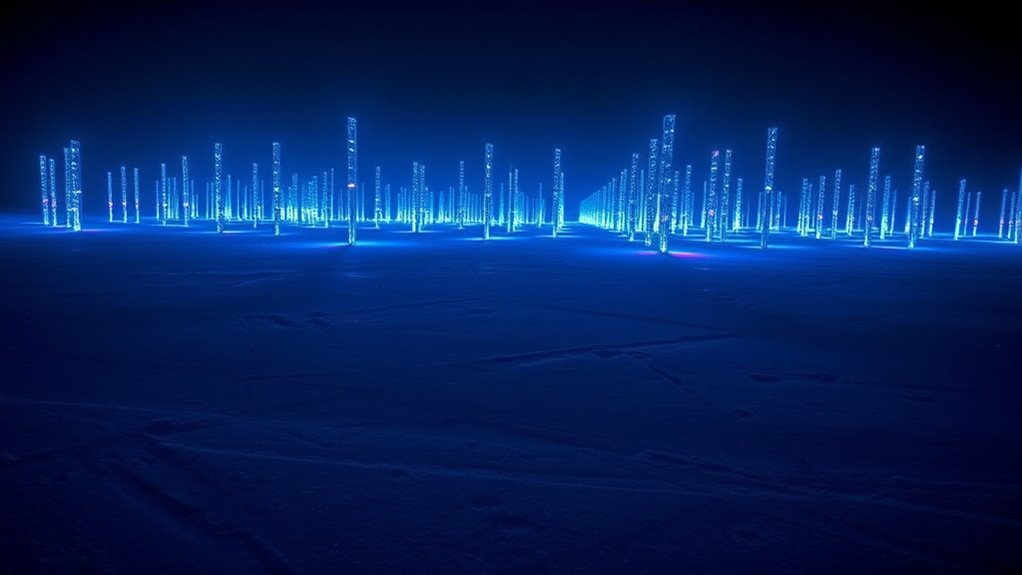
Neutrinos are incredibly elusive particles because they rarely interact with matter, making their detection a significant scientific challenge. When a high-energy neutrino passes through Antarctic ice, it can collide with atoms, producing charged particles that emit Cherenkov radiation—blue light visible to detectors. This light signals the neutrino’s presence and helps scientists trace its origin. Neutrino oscillations, where neutrinos switch between different types, improve our understanding of fundamental physics. Additionally, these particles often result from particle acceleration in cosmic events like supernovae or black hole activity. By analyzing the Cherenkov light patterns, you can determine the neutrino’s energy and trajectory, revealing insights into distant astrophysical phenomena. This detection method turns Antarctic ice into an enormous, sensitive neutrino observatory. Predictive modeling can further enhance the analysis of neutrino data, enabling more accurate identification of their sources.
Challenges Faced in Deep-Ice Neutrino Observation
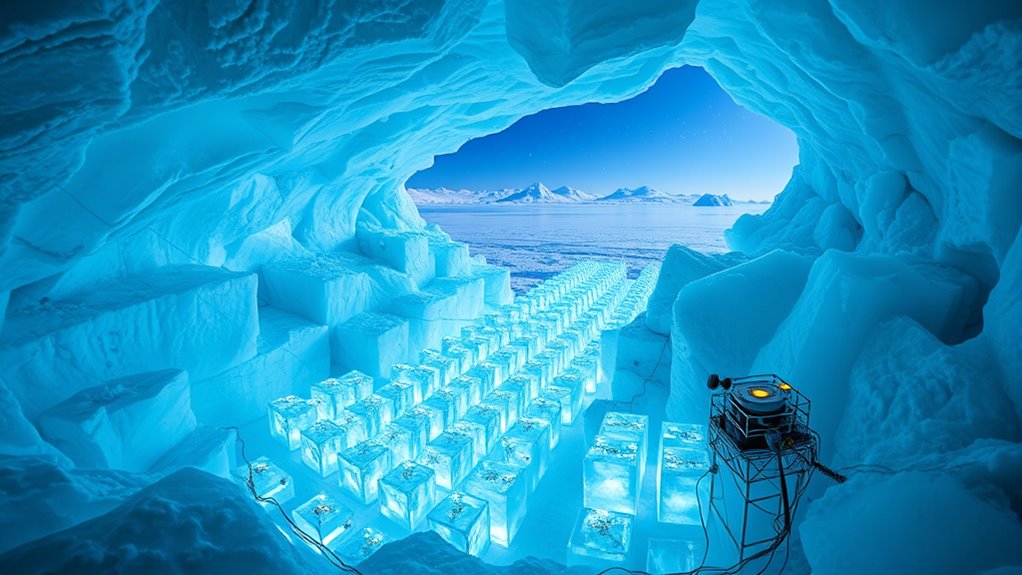
You face tough conditions when observing neutrinos deep in Antarctic ice. The harsh environment makes equipment maintenance and data collection challenging. Additionally, detecting the faint signals requires overcoming significant technical hurdles. To optimize the detection process, specialized Kia Tuning techniques can be employed to enhance sensor sensitivity and performance.
Harsh Antarctic Conditions
Operating in the extreme conditions of Antarctica presents significant hurdles for deep-ice neutrino observations. As you engage in polar exploration, you face relentless cold, high winds, and unpredictable weather, all of which challenge equipment stability and longevity. The extreme environment demands specialized materials and rigorous maintenance routines to prevent freezing or damage. Logistics become complex, with supply chains strained by remote location and harsh conditions. You must also contend with limited access during winter months, making timely repairs difficult. These factors increase risks and costs, but they’re necessary obstacles to disclose the secrets hidden beneath the ice. The extreme environment pushes your resilience and ingenuity, forcing you to develop innovative solutions for successful deep-ice neutrino detection in Antarctica’s unforgiving landscape. Additionally, the unique environmental challenges require constant adaptation of equipment and procedures to ensure reliable data collection.
Signal Detection Difficulties
Detecting signals from neutrinos deep within the ice is incredibly challenging because these particles rarely interact with matter, making their signals faint and difficult to distinguish from background noise. Neutrino oscillations can cause particles to change types, complicating identification. Precise detector calibration becomes vital to accurately interpret the signals, as even minor misalignments can lead to misidentification. The deep ice environment adds further hurdles, with natural radioactivity and other noise sources obscuring genuine neutrino events. You need sensitive equipment and rigorous calibration procedures to differentiate true signals from background interference. Calibration accuracy is critical to ensuring the reliability of the observations. Overcoming these challenges allows scientists to better understand neutrino properties and their role in the universe, despite the inherent difficulty of observing these elusive particles amid the icy depths.
Breakthrough Discoveries Made by IceCube-2

IceCube-2 has achieved remarkable breakthroughs in neutrino research, opening new windows into the universe’s most elusive particles. Its discoveries confirm neutrino oscillations, revealing how these particles change flavors as they traverse the Antarctic ice. This insight helps scientists understand neutrino properties better and refine models of the universe. Additionally, IceCube-2’s data shed light on Antarctic ice properties, showing how ice clarity and thickness influence detection. The following table summarizes key breakthroughs:
| Discovery | Impact | Significance |
|---|---|---|
| Neutrino oscillations | Confirmed flavor changes in neutrinos | Deepened understanding of neutrino behavior |
| Ice property insights | Improved detector calibration | Enhanced detection accuracy |
| Cosmic neutrino sources | Identified potential extragalactic origins | Expanded knowledge of universe’s structure |
These advances position IceCube-2 as a vital tool in unraveling cosmic mysteries.
The Role of Advanced Sensors and Data Collection Techniques

Advanced sensors are vital for detecting the faint signals from neutrinos deep beneath Antarctica. Your focus should be on how sensor technology innovations improve sensitivity and accuracy. Additionally, effective data processing strategies are essential to analyze the massive amounts of information collected. As AI technology advances, implementing robust safety measures can help ensure the integrity and reliability of data analysis in such sensitive experiments.
Sensor Technology Innovations
To uncover the elusive neutrinos passing through Antarctica, scientists rely on cutting-edge sensors that can accurately capture faint signals amid harsh conditions. These sensors use sensor fusion technology, combining data from multiple sources to improve detection accuracy and reduce false positives. Advanced materials and designs enable sensors to operate reliably in extreme cold and low-pressure environments. Energy harvesting techniques, such as capturing ambient thermal or vibrational energy, power these sensors sustainably, minimizing maintenance needs. This innovation guarantees continuous operation deep within the ice. By integrating sensor fusion with energy harvesting, the IceCube‑2 telescope enhances its sensitivity and longevity, enabling it to detect the rare interactions that reveal neutrinos’ secrets. These technological advances are vital for unlocking the universe’s most elusive particles. Additionally, incorporating AI-powered analytics can assist in processing the vast data collected, further improving detection capabilities and reducing human oversight.
Data Processing Strategies
Effective data processing strategies are essential for transforming raw signals collected by sensors into meaningful insights about neutrino interactions. You rely on data compression to reduce the enormous volume of data generated deep in Antarctica, enabling faster transmission and analysis. Implementing real-time analytics allows you to quickly identify potential neutrino events, filtering out background noise efficiently. Advanced algorithms process signals immediately, so you can make timely decisions and adjust data collection parameters on the fly. This approach minimizes data overload and ensures critical information isn’t missed. The combination of data compression and real-time analytics enhances the telescope’s capability to detect rare neutrino interactions, maximizing scientific output while managing limited bandwidth and power resources in such an extreme environment.
Collaborations and Global Efforts in Neutrino Research

Given the global scale and complexity of neutrino detection, scientists have formed collaborative efforts that span continents to share resources, data, and expertise. These collaborations enable researchers to study phenomena like neutrino oscillations, which reveal how neutrinos change types as they travel. By pooling data from detectors worldwide, teams can better understand the quantum entanglement involved in neutrino interactions, shedding light on their mysterious nature. International projects like IceCube in Antarctica and similar observatories in Europe and North America work together to improve detection methods and analyze signals. This global teamwork accelerates discoveries, fosters innovation, and helps overcome technical challenges, ensuring that neutrino research continues advancing at a rapid pace. Your participation in these efforts contributes to unraveling fundamental questions about the universe.
Potential Insights Into Cosmic Events and Mysteries
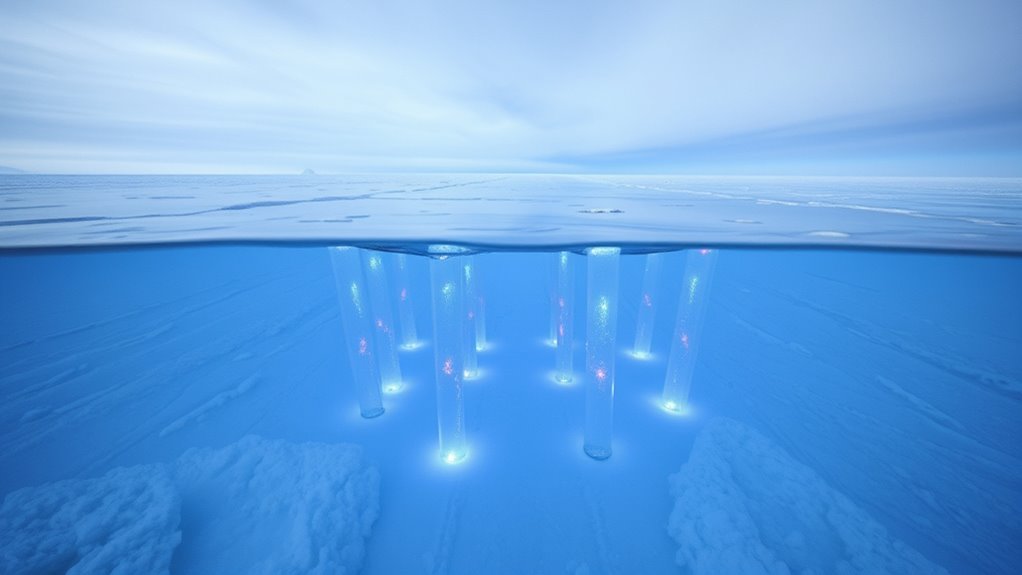
Neutrino detectors like IceCube reveal new ways to explore cosmic events that are otherwise hidden from view. By analyzing neutrino signals, you can uncover insights into phenomena like supernovae, black hole mergers, and gamma-ray bursts. Three key ways this helps include:
- Identifying neutrino oscillations that reveal neutrino properties and their origins.
- Differentiating cosmic neutrinos from atmospheric backgrounds, reducing false signals.
- Tracing the directionality of neutrinos to pinpoint their astrophysical sources.
These insights deepen your understanding of the universe’s most energetic events. They also help clarify how neutrinos traverse space, carrying unaltered information from distant cosmic phenomena. IceCube’s ability to detect these ghostly particles opens a window into mysteries that remain invisible through traditional telescopes.
Future Upgrades and Expanding the Telescope’s Capabilities
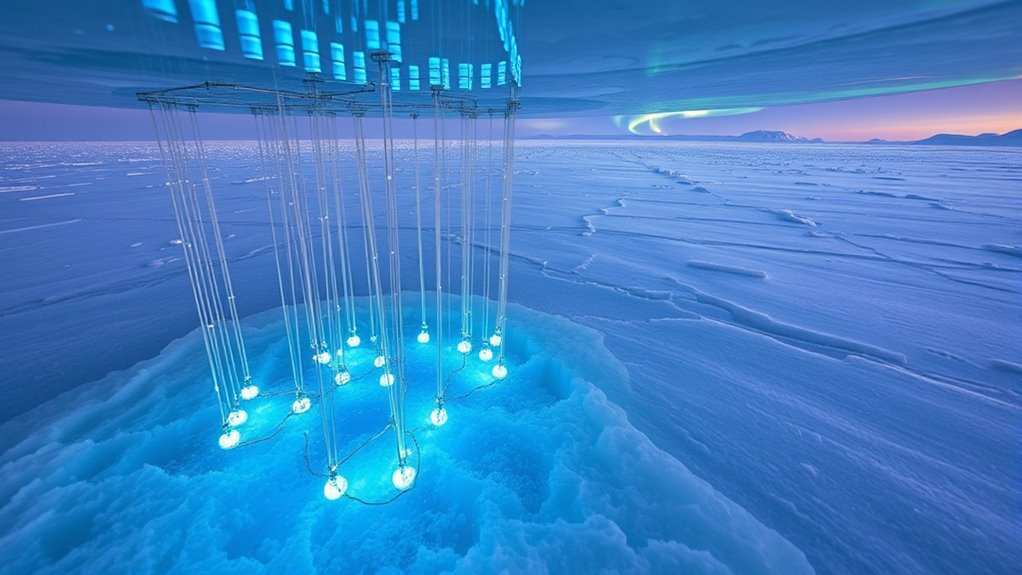
As scientists plan the next phase of IceCube’s development, they focus on integrating advanced technologies to enhance its sensitivity and coverage. Upgrades aim to better detect neutrino oscillations, which are vital for understanding their behavior and origins. New detector modules will improve the array’s ability to distinguish neutrino types and track their paths more precisely. Additionally, researchers are exploring ways to account for ice sheet dynamics, ensuring the detector remains accurate despite changes in ice properties over time. These enhancements will expand IceCube’s capacity to capture rare neutrino events, allowing for more detailed observations of cosmic phenomena. By continuously refining the instrumentation, you’ll gain deeper insights into neutrino characteristics and improve the overall performance of this groundbreaking observatory.
Implications of Neutrino Observations for Understanding the Universe

The observations made by IceCube have profound implications for our understanding of the universe. First, they help determine the neutrino mass, which influences how neutrinos behave over cosmic distances and impacts galaxy formation models. Second, detecting high-energy neutrinos sheds light on the origins of cosmic rays, revealing how particles accelerate in extreme environments like black holes or supernovae. Third, these observations allow you to explore the universe’s most energetic phenomena, offering clues about events that happened billions of years ago. By studying neutrinos, you gain insight into processes that are otherwise hidden from traditional telescopes, deepening your understanding of the universe’s structure and evolution. This pushes the boundaries of astrophysics, opening new avenues for discovery.
Frequently Asked Questions
How Do Neutrinos Differ From Other Subatomic Particles?
Neutrinos differ from other subatomic particles because they have very tiny masses and rarely interact with matter, making them difficult to detect. Their unique properties include lacking electric charge and only weakly coupling with other particles. You need specialized subatomic detection methods, like massive underground detectors, to observe neutrinos. Unlike protons or electrons, neutrinos pass through most material undetected, which makes studying them quite challenging but also fascinating for understanding the universe.
What Makes Antarctica an Ideal Location for Neutrino Telescopes?
Antarctica’s stable ice sheet makes it an ideal location for neutrino telescopes because it provides a clear, dark, and stable environment for detecting faint signals. You benefit from the ice’s transparency, allowing precise measurements. Despite remote environmental challenges like extreme cold and isolation, these conditions help reduce background noise, making Antarctica perfect for capturing elusive neutrinos that other sites can’t detect as effectively.
How Long Does It Take to Build and Deploy the Icecube-2 Detector?
Building and deploying the IceCube-2 detector takes several years, with a typical deployment timeline of about 3 to 4 years. You’ll face construction challenges like working in extreme Antarctic conditions, which slow down installation and require specialized equipment. Despite these hurdles, careful planning guarantees the project progresses efficiently, and the detector becomes operational, allowing scientists to hunt for elusive neutrinos deep beneath the ice.
Can Icecube-2 Detect Neutrinos From Earth-Based Sources?
You can use IceCube-2 to detect neutrinos from Earth-based sources, which helps in cosmic ray detection and studying neutrino oscillations. The detector’s advanced sensors pick up neutrinos produced by natural processes within our planet or nearby sources. By analyzing these signals, you gain insights into particle physics phenomena, including how neutrinos change types, and improve understanding of Earth’s interior and cosmic interactions.
What Are the Safety Measures for Maintaining Equipment in Extreme Cold?
Did you know that extreme cold can reduce equipment lifespan by up to 50%? To keep machinery safe, you implement antifreeze protocols and guarantee excellent thermal insulation. These measures prevent freezing and condensation, which can damage sensitive parts. Regular maintenance checks are vital, and you also monitor temperature levels continuously, adjusting insulation as needed. Staying proactive helps you avoid costly failures and keeps your equipment functioning at its best in Antarctica’s harsh environment.
Conclusion
As you stand beneath Antarctica’s icy veil, remember that IceCube-2 is like a giant cosmic net, catching whispers from the universe’s most elusive particles. With each neutrino it detects, you’re peeling back layers of the universe’s mystery, revealing stories written in the silent language of space. This groundbreaking telescope isn’t just observing; it’s shining a light into the dark corners of our cosmic story, helping you understand the universe’s deepest secrets.










